THE 06 BEST SPOTS FOR DIVING/SNORKELING IN NUSA PENIDA
Being a tropical island, Bali has numerous locations to go snorkeling. It can sometimes be difficult to choose from the many locations. One of the most popular snorkeling locations around Bali, are the islands of Nusa Penida. The waters between Nusa Penida and Nusa Lembongan have magnificent underwater views. So that many international divers are interested in snorkeling or diving in the waters of Nusa Bali. When you dive or snorkel in Nusa Penida, you will see the underwater scenery, such as healthy coral reefs and various aquatic life. Underwater biota that most likely you will see while snorkeling or diving, such as green sea turtles, manta rays, rainbow eels, mola-mola, and frogfish. Apart from scuba diving, tourists also try snorkeling activities to see the beauty of marine life on Nusa Penida island. The following are the best spots and are in great demand by tourists when they want to try snorkeling on Nusa Penida’s island.
1. Manta Point
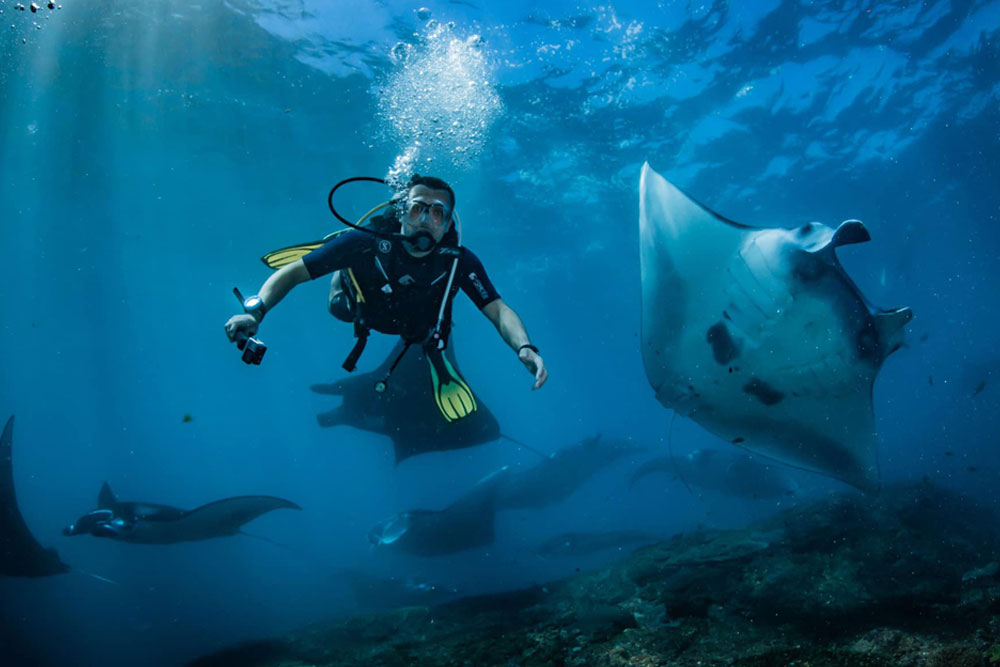
Manta point is almost in the middle of the south west coast of Nusa Penida island. If you go by land to Peguyangan waterfalls you will see a sign on the left to Manta Point. Close to a white temple you will be able to overlook the sea from the cliff and sea the manta rays from the top. There is no way to go down to the sea from there, so the only way to swim, snorkel or dive with a manta ray is to take a boat.
Manta rays really are amazing creatures that are resident in Bali year round so whenever you dive there is an extremely high chance of seeing them in the water.. Some of the mantas here have wingspans of more than three meters and all have an individually unique black, white or grey pattern on their undersides which makes identification easy.
2. Manta Bay
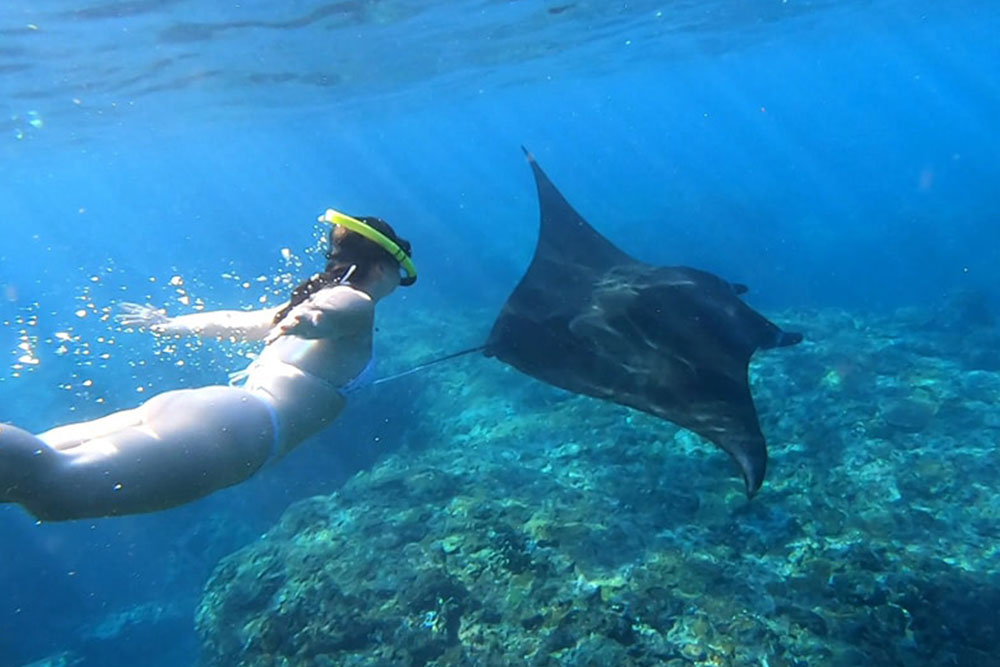
A relatively shallow area where manta rays tend to swim and feed on the surface thanks to currents rich in plankton. This is the place where most manta snorkeling trips will take you. It is not just one specific bay but rather a group of bays where mantas can be seen with a 80% chance according to the local guides.
Manta Bay provides visitors with a once-in-a-lifetime experience: swimming with manta rays! The strong currents of Nusa Penida’s waters mean that manta rays are there all-year-round to feed on plankton, which is predominantly found in Manta Bay. Visitors can opt for a Manta Ray Snorkeling Tour, which includes a boat ride out to Manta Bay. The boat captain typically keeps an eye out for manta rays and will let you know when to jump into the water.
3. Gamat Bay
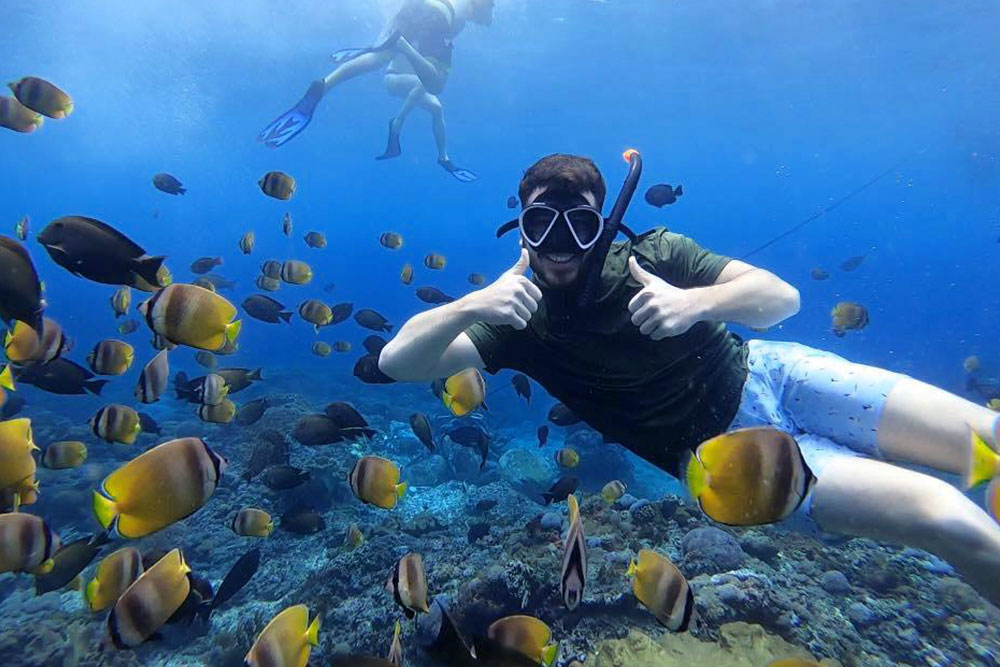
Gamat Bay is one of the most preferred spots for snorkeling activities located in the western part of Nusa Penida. The main part of the bay is quite shallow so an excellent place to complete a safety stop at the end of the dive amongst some of the clearest waters and most profuse hard and soft corals around Nusa Penida. Under the surface of the water, you can meet various types of coral and reefs. The reef sways to the rhythm of the current, while the small fish swim freely. Because the current is quite heavy, so the guide will give direction.
4. Crystal Bay
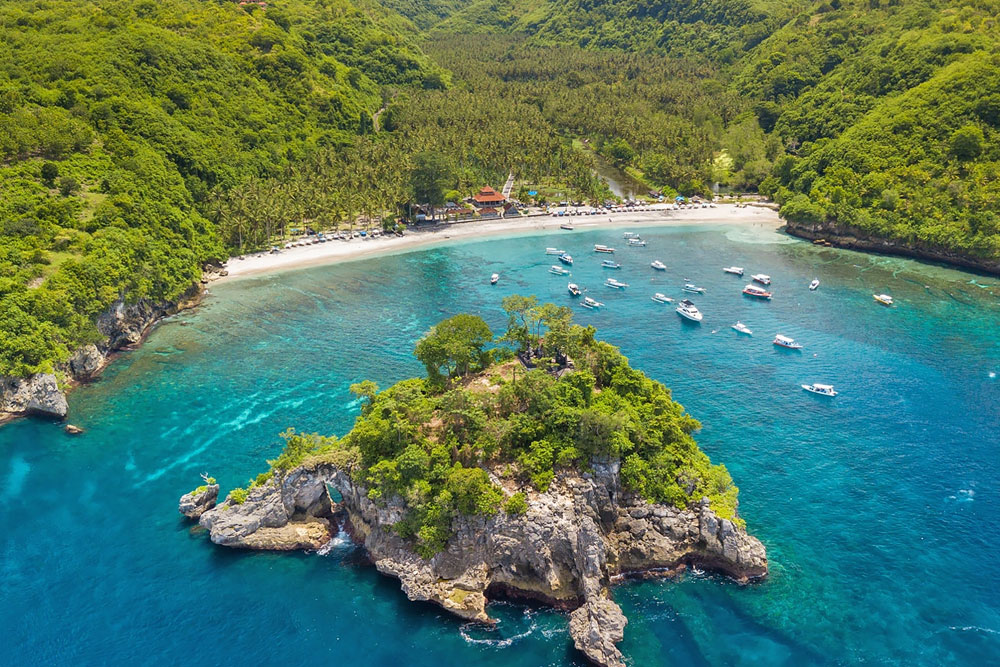
Crystal Bay is a unique dive site featuring a beautiful beach on the surface, with a long continuous and rich coral reef. In the depths, most commonly below 30 meters deep and in the cold waters of July to October, advanced divers can dive deep and spot the famous bone fish Mola Mola.
Even though Crystal Bay it’s most famous for the Sun Fish, often divers and snorkelers can spot pods of dolphins which has now become one of the main attractions. Similar to Manta Point, Crystal Bay water temperatures are cold during the months of July to October which enables the Mola Mola to come up from the deep and join divers at approximately 30 meters depth.
5. Wall Point
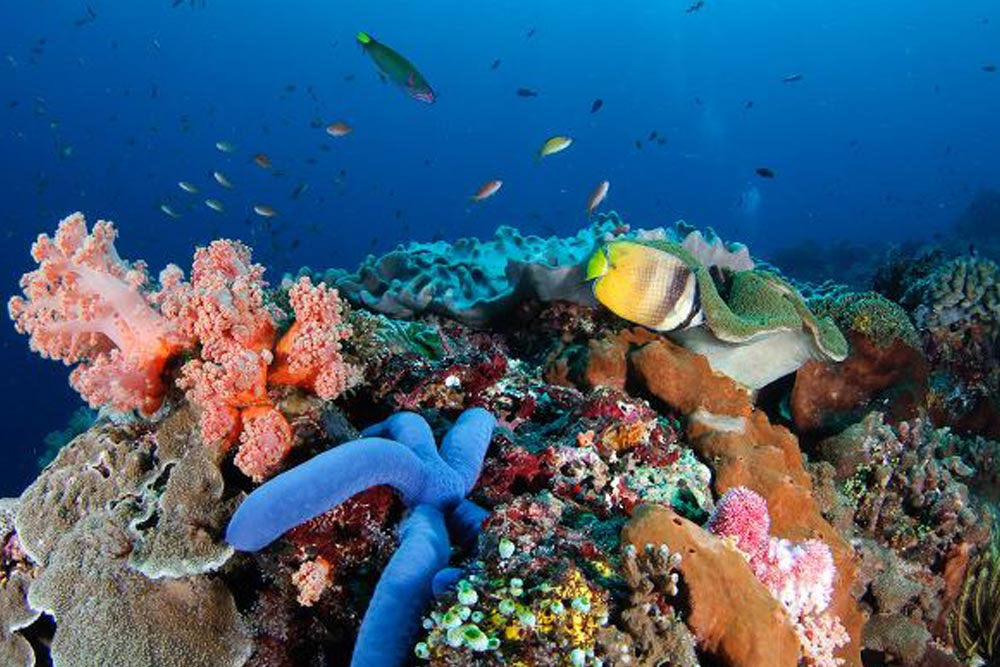
Wall point is located in Nusa Penida Island, in its southern side to be precise. This snorkeling spot is usually bundle as a daytrip snorkeling trip with other popular snorkeling spots such as Gamat Bay, Manta Point or others. Wall Point is usually the starting point to start any snorkeling tour which explore the southern part sea of the island. Why it is called Wall Point? This is because the spot is like a wall. Wall point Nusa Penida lays as a barrier between the short beach area and the deep sea of Indian Ocean. As I said before it got its name because it is a wall of coral which serves millions of fishes.
6. Mangrove Point
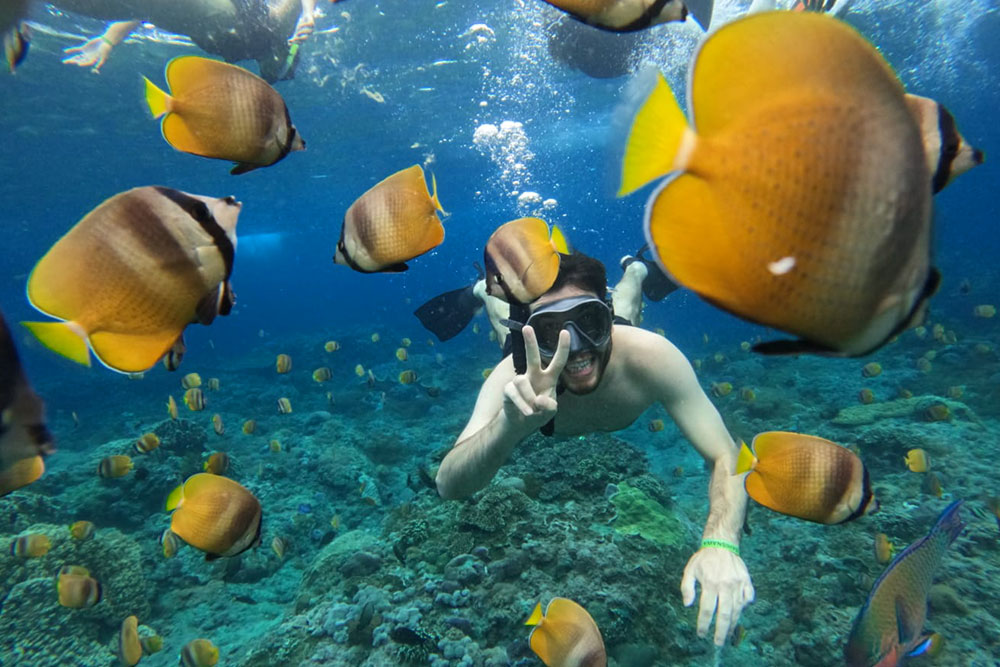
Precisely located on Nusa Lembongan, still, in one area with Nusa Penida, Mangroove Point still grows mangroves which reduce abrasion. In this place, you can see the amazing marine park that mixes mangrove forests and the high seas. Unlike other snorkeling spots, this place has a quieter current. In addition, red, green, blue, orange, purple and yellow fish swim like a rainbow. You can go to Nusa Lembongan by taking a fast boat from Nusa Penida.
 Manta point is almost in the middle of the south west coast of Nusa Penida island. If you go by land to Peguyangan waterfalls you will see a sign on the left to Manta Point. Close to a white temple you will be able to overlook the sea from the cliff and sea the manta rays from the top. There is no way to go down to the sea from there, so the only way to swim, snorkel or dive with a manta ray is to take a boat.
Manta rays really are amazing creatures that are resident in Bali year round so whenever you dive there is an extremely high chance of seeing them in the water.. Some of the mantas here have wingspans of more than three meters and all have an individually unique black, white or grey pattern on their undersides which makes identification easy.
Manta point is almost in the middle of the south west coast of Nusa Penida island. If you go by land to Peguyangan waterfalls you will see a sign on the left to Manta Point. Close to a white temple you will be able to overlook the sea from the cliff and sea the manta rays from the top. There is no way to go down to the sea from there, so the only way to swim, snorkel or dive with a manta ray is to take a boat.
Manta rays really are amazing creatures that are resident in Bali year round so whenever you dive there is an extremely high chance of seeing them in the water.. Some of the mantas here have wingspans of more than three meters and all have an individually unique black, white or grey pattern on their undersides which makes identification easy.
 A relatively shallow area where manta rays tend to swim and feed on the surface thanks to currents rich in plankton. This is the place where most manta snorkeling trips will take you. It is not just one specific bay but rather a group of bays where mantas can be seen with a 80% chance according to the local guides.
Manta Bay provides visitors with a once-in-a-lifetime experience: swimming with manta rays! The strong currents of Nusa Penida’s waters mean that manta rays are there all-year-round to feed on plankton, which is predominantly found in Manta Bay. Visitors can opt for a Manta Ray Snorkeling Tour, which includes a boat ride out to Manta Bay. The boat captain typically keeps an eye out for manta rays and will let you know when to jump into the water.
A relatively shallow area where manta rays tend to swim and feed on the surface thanks to currents rich in plankton. This is the place where most manta snorkeling trips will take you. It is not just one specific bay but rather a group of bays where mantas can be seen with a 80% chance according to the local guides.
Manta Bay provides visitors with a once-in-a-lifetime experience: swimming with manta rays! The strong currents of Nusa Penida’s waters mean that manta rays are there all-year-round to feed on plankton, which is predominantly found in Manta Bay. Visitors can opt for a Manta Ray Snorkeling Tour, which includes a boat ride out to Manta Bay. The boat captain typically keeps an eye out for manta rays and will let you know when to jump into the water.
 Gamat Bay is one of the most preferred spots for snorkeling activities located in the western part of Nusa Penida. The main part of the bay is quite shallow so an excellent place to complete a safety stop at the end of the dive amongst some of the clearest waters and most profuse hard and soft corals around Nusa Penida. Under the surface of the water, you can meet various types of coral and reefs. The reef sways to the rhythm of the current, while the small fish swim freely. Because the current is quite heavy, so the guide will give direction.
Gamat Bay is one of the most preferred spots for snorkeling activities located in the western part of Nusa Penida. The main part of the bay is quite shallow so an excellent place to complete a safety stop at the end of the dive amongst some of the clearest waters and most profuse hard and soft corals around Nusa Penida. Under the surface of the water, you can meet various types of coral and reefs. The reef sways to the rhythm of the current, while the small fish swim freely. Because the current is quite heavy, so the guide will give direction.
 Crystal Bay is a unique dive site featuring a beautiful beach on the surface, with a long continuous and rich coral reef. In the depths, most commonly below 30 meters deep and in the cold waters of July to October, advanced divers can dive deep and spot the famous bone fish Mola Mola.
Even though Crystal Bay it’s most famous for the Sun Fish, often divers and snorkelers can spot pods of dolphins which has now become one of the main attractions. Similar to Manta Point, Crystal Bay water temperatures are cold during the months of July to October which enables the Mola Mola to come up from the deep and join divers at approximately 30 meters depth.
Crystal Bay is a unique dive site featuring a beautiful beach on the surface, with a long continuous and rich coral reef. In the depths, most commonly below 30 meters deep and in the cold waters of July to October, advanced divers can dive deep and spot the famous bone fish Mola Mola.
Even though Crystal Bay it’s most famous for the Sun Fish, often divers and snorkelers can spot pods of dolphins which has now become one of the main attractions. Similar to Manta Point, Crystal Bay water temperatures are cold during the months of July to October which enables the Mola Mola to come up from the deep and join divers at approximately 30 meters depth.
 Wall point is located in Nusa Penida Island, in its southern side to be precise. This snorkeling spot is usually bundle as a daytrip snorkeling trip with other popular snorkeling spots such as Gamat Bay, Manta Point or others. Wall Point is usually the starting point to start any snorkeling tour which explore the southern part sea of the island. Why it is called Wall Point? This is because the spot is like a wall. Wall point Nusa Penida lays as a barrier between the short beach area and the deep sea of Indian Ocean. As I said before it got its name because it is a wall of coral which serves millions of fishes.
Wall point is located in Nusa Penida Island, in its southern side to be precise. This snorkeling spot is usually bundle as a daytrip snorkeling trip with other popular snorkeling spots such as Gamat Bay, Manta Point or others. Wall Point is usually the starting point to start any snorkeling tour which explore the southern part sea of the island. Why it is called Wall Point? This is because the spot is like a wall. Wall point Nusa Penida lays as a barrier between the short beach area and the deep sea of Indian Ocean. As I said before it got its name because it is a wall of coral which serves millions of fishes.
 Precisely located on Nusa Lembongan, still, in one area with Nusa Penida, Mangroove Point still grows mangroves which reduce abrasion. In this place, you can see the amazing marine park that mixes mangrove forests and the high seas. Unlike other snorkeling spots, this place has a quieter current. In addition, red, green, blue, orange, purple and yellow fish swim like a rainbow. You can go to Nusa Lembongan by taking a fast boat from Nusa Penida.
Precisely located on Nusa Lembongan, still, in one area with Nusa Penida, Mangroove Point still grows mangroves which reduce abrasion. In this place, you can see the amazing marine park that mixes mangrove forests and the high seas. Unlike other snorkeling spots, this place has a quieter current. In addition, red, green, blue, orange, purple and yellow fish swim like a rainbow. You can go to Nusa Lembongan by taking a fast boat from Nusa Penida.



